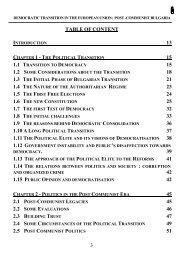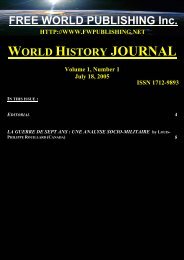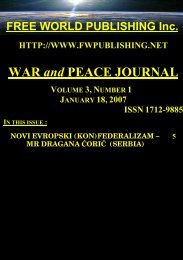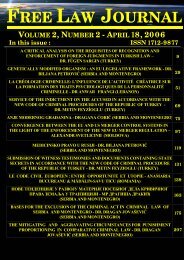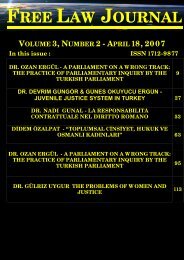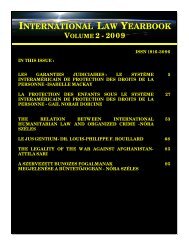Free_Law_Journal-Vol.. - Free World Publishing Inc.
Free_Law_Journal-Vol.. - Free World Publishing Inc.
Free_Law_Journal-Vol.. - Free World Publishing Inc.
You also want an ePaper? Increase the reach of your titles
YUMPU automatically turns print PDFs into web optimized ePapers that Google loves.
FREE LAW JOURNAL - VOLUME 1, NUMBER 1 (18 JULY 2005)<br />
In Ordo iudiciorum privatorum procedure, the actions are carried out in two stages. The first stage is<br />
constituted before a magistrate (praetor) and the second stage is constituted before the iudex. The plaintiff<br />
and the defendant explain the contentious issue by exposing their claims and defences before praetor.<br />
This is called the proceeding in iure. At the close of the proceeding in iure, the second stage of the civil<br />
procedure begins. This stage is named as proceeding apud iudicem 15 . If praetor believes that there is a<br />
real enmity between the parties, he grants an action, if not, he refuses to grant an action. But the decision<br />
of granting an action or refusing to grant an action given by praetor is completely different from the<br />
decision given by the judge at the end of an action. This means that, the decision of praetor does not<br />
regarded as a res iudicata like the decision of the judge given at the end of an action as condemning or<br />
discharging the plaintiff, nor it does not produce the effects of joinder of issue phase. In other words, the<br />
plaintiff can ask for an action about this contentious issue from another praetor.<br />
At this point, we must find out whether praetor turns definite judgement to account by himself,<br />
spontaneously or definite judgement can only be taken into consideration intervention by an exception 16 .<br />
Bringing an action subsequently before the court with reference to the same contentious issue of the first<br />
action is prohibited whether by ius civile, ipso iure or by praetorian law, ope exceptionis 17 . Under the<br />
older procedure of legis actiones, definite judgement is taken into consideration in all cases at civil law,<br />
ipso iure, that is spontaneously by iudex. But under the classical formulary procedure, a different method<br />
is operated: Definite judgement is taken into consideration ope exceptionem when the action is a real<br />
action (actio in rem) 18 or if it is a personal action (actio in personam) 19 when the proceedings are by<br />
iudicium imperio continens 20 or when the formula is in factum concepta 21 . During the actions in the form<br />
of iudicia legitima, iudex takes definite judgement into consideration spontaneously.<br />
liable by the joinder of issue. But if judgement is rendered against him, the obligation produced by the joinder of issue is<br />
disposed of, and he becomes liable under the judgement. This is the reason why it was stated by the ancient authorities that a<br />
debtor is compelled to make payment before issue has been joined; for after this has been done, he will be liable if judgement<br />
should be rendered against him, and if he is condemned, he will be compelled to satisfy the judgement”; Betti, p. 601 sq.<br />
14 Marrone, M.; “L’Efficacia Pregiudiziale delle Sentenza nel Processo Civile Romano”, Annali Palermo, V. 24 1955, p. 304<br />
sq.; Wenger, p. 179; Litis contestatio phase, has a special feature like renewing the obligation. That is why, an obligation which<br />
has ended by renewing in joinder of issue phase, can not be a subject of action.<br />
15 Schulz, s. 14; Zulueta, p. 226; At this stage, the judge, whom is charged to give up a claim, examines the plaintiff’s claim and<br />
then pronounces the judgement about either the dismission of the plaintiff or condemnation of the defendant. Proceeding apud<br />
iudicem is oral and informal. But parties have a right to be heard, but if one party does nor appear , the judgement goes against<br />
him.<br />
16 Pugliese, G.: “L’Actio e la Litis Contestatio nella Storia del Processo Romano” Studi in Onore di Enrico Tullio Liebman, V.<br />
1, 1979, p. 411 sq. (Actio)<br />
17 Marrone, p. 317; Provera, p. 24.<br />
18 Gai. 4, 3; A real action is one in which we either claim some corporeal property to be ours, or that we are entitled to some<br />
particular right in the property, for instance, the right of use and enjoyment; or the right to walk and drive through the land of<br />
another; or to conduct water from his land; or to raise the height of a building, or to have the view unobstructed; or when a<br />
negative action is brought by the adverse party.; Zulueta, p. 228; The distinction in rem and in personam is a physical<br />
distinction.<br />
19 Gai. 4, 2; A personal action is one which we bring against anyone who is liable to us under a contract, or on account of a<br />
crime, that is what we claim is that he is bound to give something, to do something or to perform some service.<br />
20 Gai. 4, 103; Actions are either founded upon law or are derived from the authority of a magistrate.<br />
21 Gai. 4, 45; We say that the formulas in which a question of right is involved, are founded in law; as for instance, when we<br />
assert that any property belongs to us by quiritarian right, or that the adverse party is obliged to pay us something, or make<br />
good a loss to us as a thief, for these formulas and others are those in which the claim is based on the Civil <strong>Law</strong>. Gai. 4, 46; We<br />
say that other formulas are based upon questions of fact, that is, where a claim of this kind is not made with reference to them;<br />
but where a fact is stated in the beginning of a formula, words are added by which authority is given to the judge to condemn or<br />
discharge the defendant. This kind of a formula is employed by a patron against his freedman, when the latter brings him court<br />
contrary to the Edict of the praetor for then it is in the following terms: Let so-and so be judges. If it is established that suchand<br />
such a patron, was brought into court by such-and such freedman, contrary to the Edict of such-and such praetor –judges,<br />
GOKCE TURKOGLU-OZDEMIR - “BIS DE EADEM RE NE SIT ACTIO” PRINCIPLE IN THE FORMULARY SYSTEM OF ROMAN LAW OF PROCEDURE 143






